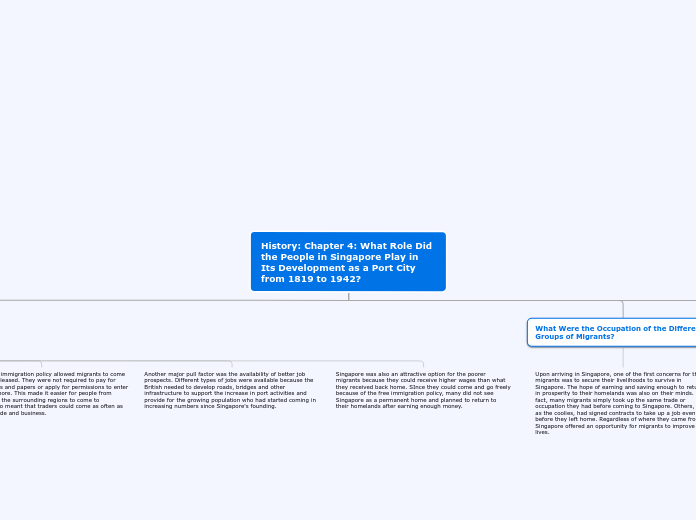History: Chapter 4: What Role Did the People in Singapore Play in Its Development as a Port City from 1819 to 1942?
Why Did Migrants Come to Singapore After 1819?
Just as it is today, it was not easy for people in the past to leave their homelands and start anew in a foreign land far away. Not only did the migrants have to brave the dangers of long-distance travel, such as shipwrecks and disease, they also faced much uncertainty about the future in the lands where they eventually settled. Thus, for migrants to come to Singapore after 1819, they had to have strong reasons for leaving their homelands, and Singapore must have had quantities which drew them here.
Push Factors
Push factors refer to unfavourable circumstances that motivate people to settle elsewhere. Many of the migrants left their homelands because of the poor living conditions. Some experienced hunger and poverty while others feared for their lives. These problems were often brought about by overpopulation, natural disasters or conflict. For example, many in China, India and Southeast Asia were affected by the unrest and instability caused by wars, rebellions and lawlessness in the 19th and early 20th centuries. The people worried about their families' and their own safety. It also became difficult for them to earn a livelihood. As a result, they left to seek more peaceful and prosperous lives elsewhere.
Pull Factors
Pull factors are the favourable conditions that attract people to move to a new place. While push factors made people leave their homelands, pull factors attracted them to find work in Singapore. The major pull factor in the 19th and 20th centuries were trade and business opportunities, and better job prospects.
The many trading and business opportunities available in Singapore attracted people from Europe, India, China and neighbouring countries.
With its excellent geographical location, Singapore served as a convenient meeting point for traders from many parts of the world stopping to replenish their fuel and food supplies. Taking advantage of its good location and trading networks, numerous traders came to Singapore for the many diverse goods that could be found and traded. By exchanging or selling their goods and buying local products, they were able to obtain what they needed and return home.
Singapore's free port status meant that traders did not have to pay taxes or trade. This enabled them to make larger profits in Singapore than in other ports in the region.
Singapore's free immigration policy allowed migrants to come and go as they pleased. They were not required to pay for immigrant passes and papers or apply for permissions to enter and leave Singapore. This made it easier for people from China, India and the surrounding regions to come to Singapore. It also meant that traders could come as often as they liked for trade and business.
Another major pull factor was the availability of better job prospects. Different types of jobs were available because the British needed to develop roads, bridges and other infrastructure to support the increase in port activities and provide for the growing population who had started coming in increasing numbers since Singapore's founding.
Singapore was also an attractive option for the poorer migrants because they could receive higher wages than what they received back home. SInce they could come and go freely because of the free immigration policy, many did not see Singapore as a permanent home and planned to return to their homelands after earning enough money.
What Were the Occupation of the Different Groups of Migrants?
Upon arriving in Singapore, one of the first concerns for the migrants was to secure their livelihoods to survive in Singapore. The hope of earning and saving enough to return in prosperity to their homelands was also on their minds. In fact, many migrants simply took up the same trade or occupation they had before coming to Singapore. Others, such as the coolies, had signed contracts to take up a job even before they left home. Regardless of where they came from, Singapore offered an opportunity for migrants to improve their lives.
Entrepreneurs
Traders
When Singapore was founded, the first group of people who came were the traders. Many traders were attracted by the favourable trade policies. These traders engaged in commercial activities along the Singapore River. Boat Quay became the busiest part of the river, with many shophouses and warehouses lining the riverbank.
Some Europeans also set up agency houses here. In return for their services, they received a commission. Some of these agency houses include A. L. Johnston & Company (established in 1820 by Alexander Laurie Johnston) and Boustead & Company (established in 1828 by Edward Boustead).
The Europeans who set up the agency houses often had difficulty dealing with Asian traders because of their differences in language. Thus, the Chinese Peranakans, who could speak English, Malay and Chinese dialects, Played a significant role in facilitating communication between the European and Asian traders.
Several Chinese Peranakans even set up their own trading businesses in Singapore. Among them was Melakan-born Tan Kim Seng, who became one of the most well-known members of the Chinese community during the colonial period.
Apart from the European agency houses and Chinese traders from various parts of the Malay Archipelago were also attracted by Singapore's free port status. One trader who arrived in the 1800s was Melakan-born Hajjah Fatimah Sulaiman. Having lost her husband at a young age, she continued and expanded his business in Singapore, gaining great wealth in the process.
Yet another
Subtopic
Street Traders
